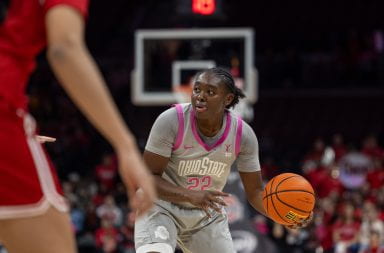Ohio State coach Urban Meyer and Wisconsin coach Bret Bielema butted heads last winter over the first-year Buckeyes coach’s recruiting practices, but the two came to agreement about one thing on Tuesday: the meeting between OSU and Wisconsin this weekend will add another chapter in the “rivalry” between the two schools.
Now, the two don’t play for some special trophy, as seen in some of college football’s more celebrated rivalry games. And, historically, there has been little parody between the Buckeyes and Badgers. In fact, OSU holds a 54-18-5 all-time record against Wisconsin.
But has the series developed into a rivalry? Absolutely, and it isn’t going anywhere.
Since 1999 OSU and Wisconsin have traded punches, with OSU holding a 6-5 advantage heading into Saturday’s Round 12. In that span, the programs have combined to win at least a share of the Big Ten title nine times.
“What makes a good rivalry is when two good teams play significant games,” Meyer said Tuesday.
The games have been significant. The results even more so.
In 2003, OSU, the defending national champions at the time, entered Wisconsin’s Camp Randall Stadium riding a 19-game winning streak, but couldn’t extend it to 20 after falling to the Badgers, 17-10.
In 2010 the Buckeyes returned home from Madison, Wisc., in a similar fashion, after Wisconsin upset then-No.1 and undefeated OSU, 31-18.
Sensing a theme here?
The lower-ranked team has achieved an upset in 5 of the past 11 meetings. This includes OSU’s improbable 33-29 win last year, which Bielema called “heartbreaking.”
And that cuts right to the heart of this rivalry. It’s about more than just beating your opponent. It’s about devastating them; it’s about squashing their lofty aspirations.
“We’ve had a big rivalry with them, almost as big as (the rivalry with Michigan),” said senior linebacker Zach Boren, while referring to the Wolverines as “the team up north.”
Will Wisconsin henceforth be referred to only as “the team to the west?” Will the OSU-Wisconsin rivalry reach a similar boiling point to that of OSU and Michigan? Probably not.
“The Game’s” sentimental history will always loom large over any other rivalry in Buckeye lore.
But from a pure-football standpoint, it’s becoming just as significant, if not more.
For one, the OSU-Wisconsin series has been more competitive. While the Buckeyes and Badgers went back-and-forth in recent years, OSU has largely dominated Michigan. It was a similar, but flipped script in the 1990s, when Michigan went 7-2-1 against the Buckeyes.
More importantly, when the Big Ten went to a two-division setup in 2011, we entered a world in which OSU’s most important contest will annually be against Wisconsin.
Think I’m kidding? Including OSU, there are six teams in the Big Ten’s Leaders division. One is Wisconsin, which poses a legitimate threat to complete Buckeye dominance of the division during Meyer’s tenure in Columbus. The other four are sanctioned-Penn State, Illinois, Indiana and Purdue, which simply don’t.
Playing in the same division, OSU and Wisconsin are guaranteed to hook up every year. The same can be said for OSU and Michigan, but because they are in separate divisions, there is a chance that “The Game” could be played twice in consecutive weekends if the two teams were to again meet up in the conference’s championship game.
Don’t you think a November meeting between OSU and Michigan will be diminished, just a little bit, when we know we’ll see the same matchup just a week later? Won’t the sequel feel like, well, a sequel?
The rivalry with Wisconsin won’t, simply because it can’t. The Buckeyes and Badgers have just one shot at each other each year, no exceptions. There will be a winner and a loser, and that loser will have no choice but to spend the next year counting the passing days, waiting for their chance at payback.
One team’s countdown will begin Saturday night.
“I want to win in the worst way because Ohio State has set the standard for winning in this league,” Bielema said Tuesday.
Translation: I want to win in the worst way because I can’t stand seeing these guys beat us, I can’t stand seeing them win.
It’s a sentiment that I imagine is shared by both sides in what’s becoming the Big Ten’s most important rivalry.


